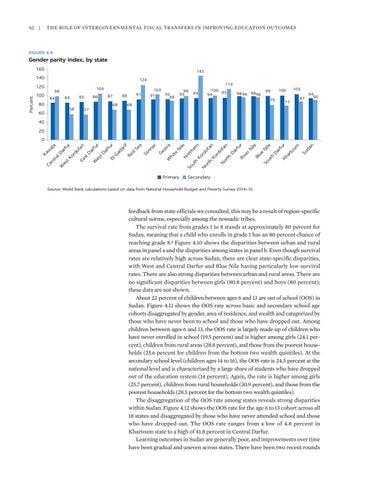62 | The Role of Intergovernmental Fiscal Transfers in Improving Education Outcomes
FIGURE 4.9
Gender parity index, by state 160
145
140
100
124 104
98 84
80
84 58
60
85
86
87 68
91
88
103 92 91 88
99 93
94
114 100 95 98 96 9896 94
99 79
68
100
103
77
87
94 90
57
40 20
Primary
Su da n
ar G ez ira W hi te N ile No So rth ut er h n Ko r No do rth fa n K or do No fa n rth D ar fu r Ri ve rN ile Bl ue Ni So le ut h D ar fu r Kh ar to um
Se nn
Ka ss al a ra l D W a es rfu tK r or do fa Ea n st D ar fu W r es tD ar fu r El -G ad ar if Re d Se a
0
Ce nt
Percent
120
Secondary
Source: World Bank calculations based on data from National Household Budget and Poverty Survey 2014–15.
feedback from state officials we consulted, this may be a result of region-specific cultural norms, especially among the nomadic tribes. The survival rate from grades 1 to 8 stands at approximately 80 percent for Sudan, meaning that a child who enrolls in grade 1 has an 80 percent chance of reaching grade 8.2 Figure 4.10 shows the disparities between urban and rural areas in panel a and the disparities among states in panel b. Even though survival rates are relatively high across Sudan, there are clear state-specific disparities, with West and Central Darfur and Blue Nile having particularly low survival rates. There are also strong disparities between urban and rural areas. There are no significant disparities between girls (80.8 percent) and boys (80 percent); these data are not shown. About 22 percent of children between ages 6 and 13 are out of school (OOS) in Sudan. Figure 4.11 shows the OOS rate across basic and secondary school age cohorts disaggregated by gender, area of residence, and wealth and categorized by those who have never been to school and those who have dropped out. Among children between ages 6 and 13, the OOS rate is largely made up of children who have never enrolled in school (19.5 percent) and is higher among girls (24.1 percent), children from rural areas (28.8 percent), and those from the poorest households (25.6 percent for children from the bottom two wealth quintiles). At the secondary school level (children ages 14 to 16), the OOS rate is 24.5 percent at the national level and is characterized by a large share of students who have dropped out of the education system (14 percent). Again, the rate is higher among girls (25.7 percent), children from rural households (30.9 percent), and those from the poorest households (28.5 percent for the bottom two wealth quintiles). The disaggregation of the OOS rate among states reveals strong disparities within Sudan. Figure 4.12 shows the OOS rate for the age 6 to 13 cohort across all 18 states and disaggregated by those who have never attended school and those who have dropped out. The OOS rate ranges from a low of 4.8 percent in Khartoum state to a high of 41.8 percent in Central Darfur. Learning outcomes in Sudan are generally poor, and improvements over time have been gradual and uneven across states. There have been two recent rounds






